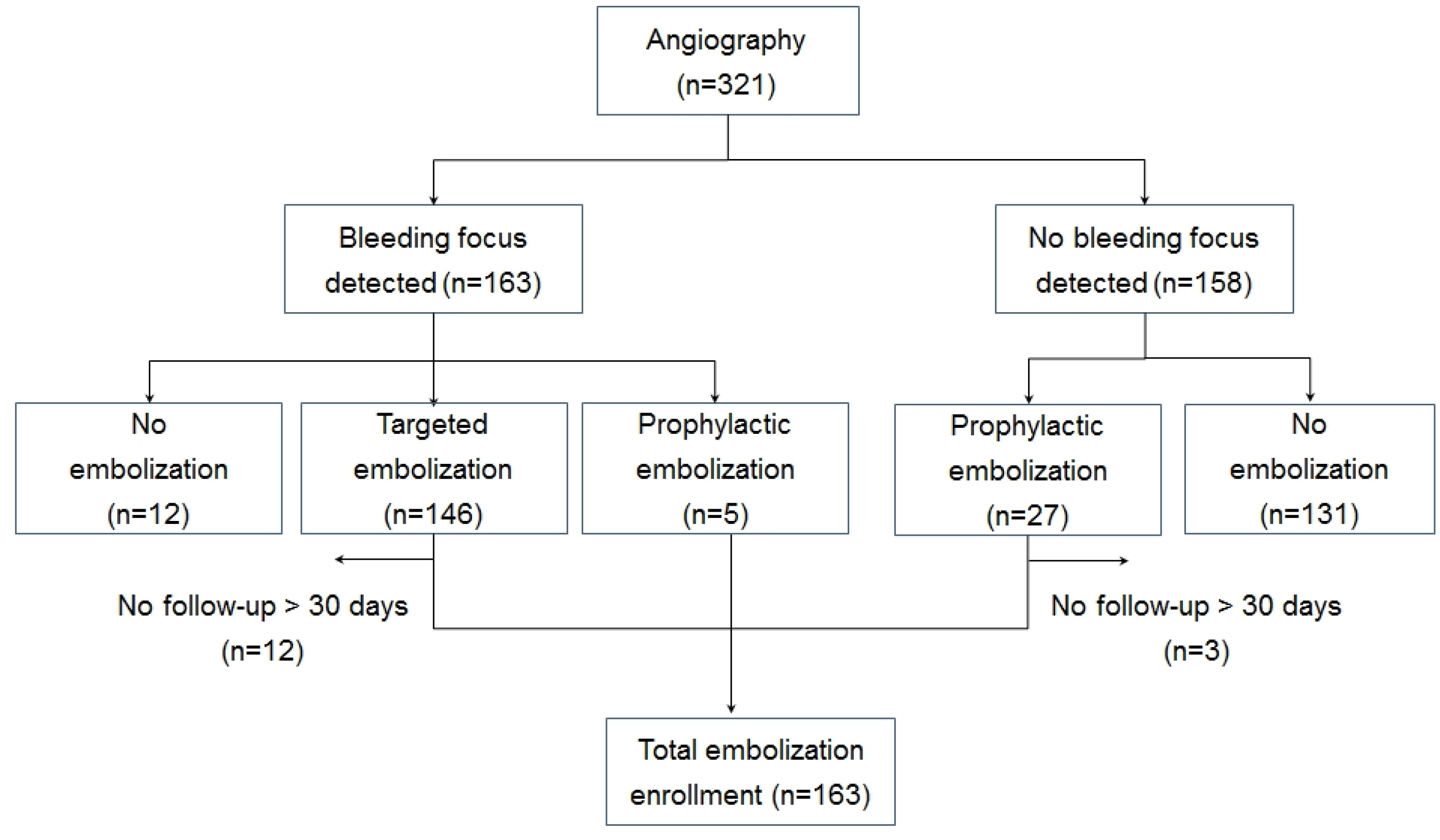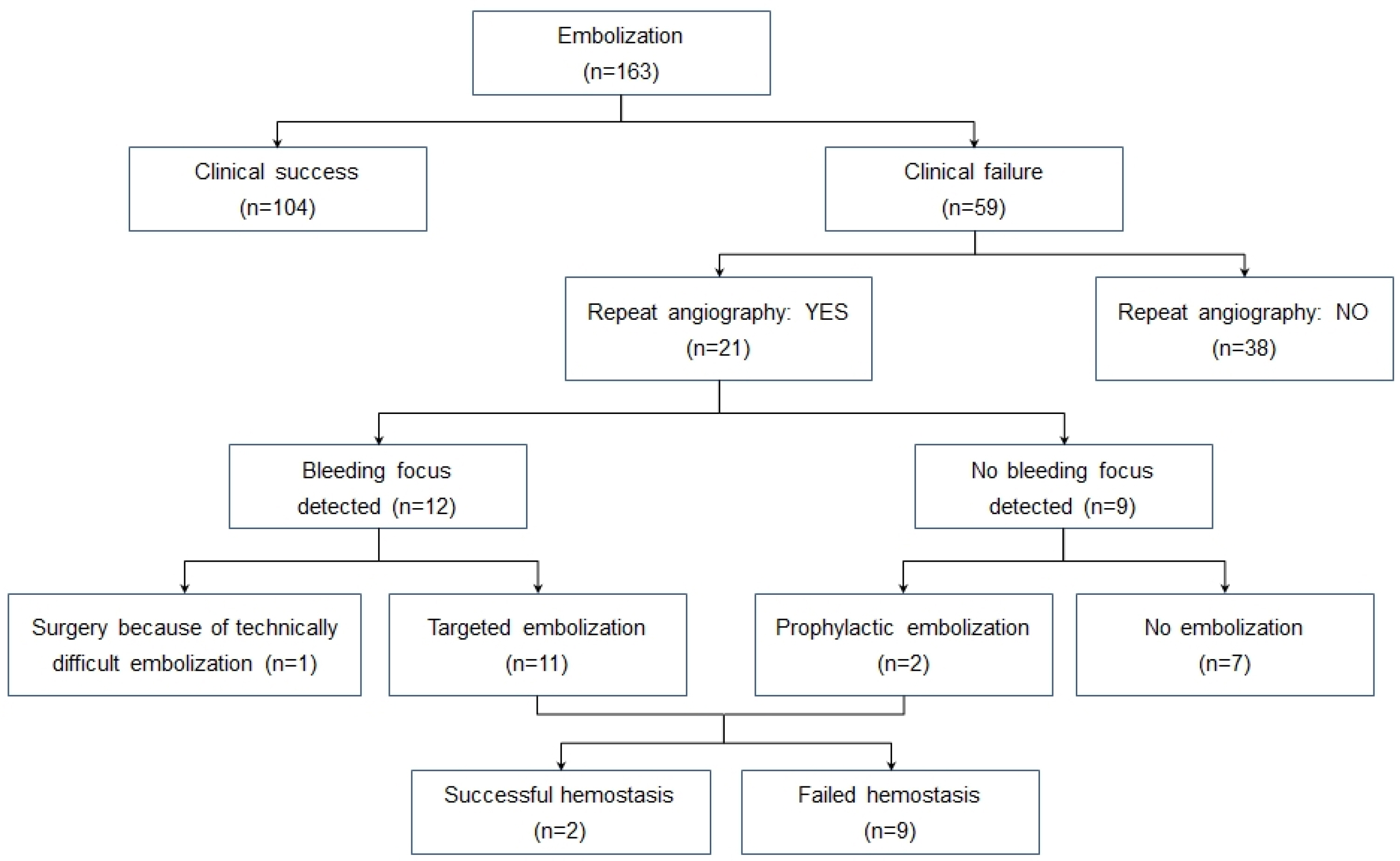Korean J Gastroenterol.
2018 Apr;71(4):219-228. 10.4166/kjg.2018.71.4.219.
Clinical Outcomes of Angiography and Transcatheter Arterial Embolization for Acute Gastrointestinal Bleeding: Analyses according to Bleeding Sites and Embolization Types
- Affiliations
-
- 1Department of Internal Medicine, Asan Medical Center, University of Ulsan College of Medicine, Seoul, Korea.
- 2Department of Radiology, Asan Medical Center, University of Ulsan College of Medicine, Seoul, Korea.
- 3Division of Gastroenterology, Department of Internal Medicine, Asan Medical Center, University of Ulsan College of Medicine, Seoul, Korea. jsbyeon@amc.seoul.kr
- KMID: 2409891
- DOI: http://doi.org/10.4166/kjg.2018.71.4.219
Abstract
- BACKGROUND/AIMS
The clinical outcomes of angiography and transcatheter arterial embolization (TAE) for acute gastrointestinal bleeding (GIB) have not been completely assessed, especially according to bleeding sites. This study aimed to assess the efficacy of angiography and safety of TAE in acute GIB.
METHODS
This was a retrospective study evaluating the records of 321 patients with acute GIB who underwent angiography with or without TAE. Targeted TAE was conducted in 134 patients, in whom angiography showed bleeding sources. Prophylactic TAE was performed in 29 patients when the bleeding source was not detected but a specific vessel was strongly suspected by other examinations. The rate of technical success, clinical success, and complications were analyzed.
RESULTS
The detection rate of bleeding source via angiography was 50.8% (163/321), which was not different according to the bleeding sites. The detection rate was higher if the probable bleeding source had already been found by another investigation (59.7% vs. 35.8%, p<0.001). TAE sites were upper GIB in 67, mid GIB in 74, and lower GIB in 22. The technical success rate was 99.3% (133/134), and the clinical success rate was 63.0% (104/163). The prophylactic embolization group showed lower clinical success rate than the targeted embolization group (44.8% vs. 67.9%, p=0.06). The TAE-related complication rate was 12.9% (21/163). Ischemia and/or infarction was more common after TAE for mid and lower GIB than for upper GIB (15.6% vs. 3.0%, p=0.007).
CONCLUSIONS
Angiography with or without TAE was an effective method for acute GIB. Targeted embolization should be performed if possible given that it has a higher clinical success rate.
MeSH Terms
Figure
Reference
-
References
1. Dye CE, Gaffney RR, Dykes TM, Moyer MT. Endoscopic and radiographic evaluation of the small bowel in 2012. Am J Med. 2012; 125:1228. e1–1228.e12.
Article2. Raju GS, Gerson L, Das A, Lewis B. American Gastroenterological Association. American Gastroenterological Association (AGA) institute medical position statement on obscure gastrointestinal bleeding. Gastroenterology. 2007; 133:1694–1696.
Article3. Church NI, Palmer KR. Ulcers and nonvariceal bleeding. Endoscopy. 2003; 35:22–26.
Article4. Barkun A, Bardou M, Marshall JK. Nonvariceal Upper GI Bleeding Consensus Conference Group. Consensus recommendations for managing patients with nonvariceal upper gastrointestinal bleeding. Ann Intern Med. 2003; 139:843–857.
Article5. Rollhauser C, Fleischer DE. Nonvariceal upper gastrointestinal bleeding. Endoscopy. 2004; 36:52–58.
Article6. Schenker MP, Duszak R Jr, Soulen MC, et al. Upper gastrointestinal hemorrhage and transcatheter embolotherapy: clinical and technical factors impacting success and survival. J Vasc Interv Radiol. 2001; 12:1263–1271.
Article7. Mirsadraee S, Tirukonda P, Nicholson A, Everett SM, McPherson SJ. Embolization for nonvariceal upper gastrointestinal tract haemorrhage: a systematic review. Clin Radiol. 2011; 66:500–509.
Article8. Lee IK, Kim YM, Kim J, et al. Superselective transarterial embolization for the management of acute gastrointestinal bleeding. J Korean Radiol Soc. 2006; 54:167–173.
Article9. Haglund U, Bergqvist D. Intestinal ischemia – the basics. Langenbecks Arch Surg. 1999; 384:233–238.
Article10. Dhatt HS, Behr SC, Miracle A, Wang ZJ, Yeh BM. Radiological evaluation of bowel ischemia. Radiol Clin North Am. 2015; 53:1241–1254.
Article11. Wiesner W, Khurana B, Ji H, Ros PR. CT of acute bowel ischemia. Radiology. 2003; 226:635–650.
Article12. Kwak HS, Han YM, Lee ST. The clinical outcomes of transcatheter microcoil embolization in patients with active lower gastrointestinal bleeding in the small bowel. Korean J Radiol. 2009; 10:391–397.
Article13. Maleux G, Roeflaer F, Heye S, et al. Longterm outcome of transcatheter embolotherapy for acute lower gastrointestinal hemorrhage. Am J Gastroenterol. 2009; 104:2042–2046.
Article14. Huang CC, Lee CW, Hsiao JK, et al. N-butyl cyanoacrylate embolization as the primary treatment of acute hemodynamically unstable lower gastrointestinal hemorrhage. J Vasc Interv Radiol. 2011; 22:1594–1599.
Article15. Kim BS, Li BT, Engel A, et al. Diagnosis of gastrointestinal bleeding: a practical guide for clinicians. World J Gastrointest Pathophysiol. 2014; 5:467–478.
Article16. Sildiroglu O, Muasher J, Arslan B, et al. Outcomes of patients with acute upper gastrointestinal nonvariceal hemorrhage referred to interventional radiology for potential embolotherapy. J Clin Gastroenterol. 2014; 48:687–692.
Article17. Pennoyer WP, Vignati PV, Cohen JL. Mesenteric angiography for lower gastrointestinal hemorrhage: are there predictors for a positive study? Dis Colon Rectum. 1997; 40:1014–1018.
Article18. Gunderman R, Leef J, Ong K, Reba R, Metz C. Scintigraphic screening prior to visceral arteriography in acute lower gastrointestinal bleeding. J Nucl Med. 1998; 39:1081–1083.19. Steer ML, Silen W. Diagnostic procedures in gastrointestinal hemorrhage. N Engl J Med. 1983; 309:646–650.
Article20. Gerson LB, Fidler JL, Cave DR, Leighton JA. ACG clinical guideline: diagnosis and management of small bowel bleeding. Am J Gastroenterol. 2015; 110:1265–1287.
Article21. Okazaki M, Higashihara H, Koganemaru F, Ono H, Hoashi T, Kimura T. A coaxial catheter and steerable guidewire used to embolize branches of the splanchnic arteries. AJR Am J Roentgenol. 1990; 155:405–406.
Article22. Matsumoto AH, Suhocki PV, Barth KH. Superselective gelfoam embolotherapy using a highly visible small caliber catheter. Cardiovasc Intervent Radiol. 1988; 11:303–306.23. Shin JH. Recent update of embolization of upper gastrointestinal tract bleeding. Korean J Radiol. 2012; 13(Suppl 1):S31–S39.
Article24. Holme JB, Nielsen DT, Funch-Jensen P, Mortensen FV. Transcatheter arterial embolization in patients with bleeding duodenal ulcer: an alternative to surgery. Acta Radiol. 2006; 47:244–247.
Article25. Larssen L, Moger T, Bjørnbeth BA, Lygren I, Kløw NE. Transcatheter arterial embolization in the management of bleeding duodenal ulcers: a 5.5-year retrospective study of treatment and outcome. Scand J Gastroenterol. 2008; 43:217–222.
Article26. Loffroy R, Guiu B, Cercueil JP, et al. Refractory bleeding from gastroduodenal ulcers: arterial embolization in high-operative-risk patients. J Clin Gastroenterol. 2008; 42:361–367.27. Poultsides GA, Kim CJ, Orlando R 3rd, Peros G, Hallisey MJ, Vignati PV. Angiographic embolization for gastroduodenal hemorrhage: safety, efficacy, and predictors of outcome. Arch Surg. 2008; 143:457–461.28. Loffroy R, Guiu B, D'Athis P, et al. Arterial embolotherapy for endoscopically unmanageable acute gastroduodenal hemorrhage: predictors of early rebleeding. Clin Gastroenterol Hepatol. 2009; 7:515–523.
Article29. Yap FY, Omene BO, Patel MN, et al. Transcatheter embolotherapy for gastrointestinal bleeding: a single center review of safety, efficacy, and clinical outcomes. Dig Dis Sci. 2013; 58:1976–1984.
Article30. Arrayeh E, Fidelman N, Gordon RL, et al. Transcatheter arterial embolization for upper gastrointestinal nonvariceal hemorrhage: is empiric embolization warranted? Cardiovasc Intervent Radiol. 2012; 35:1346–1354.
Article31. Ichiro I, Shushi H, Akihiko I, Yasuhiko I, Yasuyuki Y. Empiric transcatheter arterial embolization for massive bleeding from duodenal ulcers: efficacy and complications. J Vasc Interv Radiol. 2011; 22:911–916.
Article32. Loffroy R, Lin M, Thompson C, Harsha A, Rao P. A comparison of the results of arterial embolization for bleeding and nonbleeding gastroduodenal ulcers. Acta Radiol. 2011; 52:1076–1082.
Article33. Walker TG, Salazar GM, Waltman AC. Angiographic evaluation and management of acute gastrointestinal hemorrhage. World J Gastroenterol. 2012; 18:1191–1201.
Article34. Hongsakul K, Pakdeejit S, Tanutit P. Outcome and predictive factors of successful transarterial embolization for the treatment of acute gastrointestinal hemorrhage. Acta Radiol. 2014; 55:186–194.
Article35. Gillespie CJ, Sutherland AD, Mossop PJ, Woods RJ, Keck JO, Heriot AG. Mesenteric embolization for lower gastrointestinal bleeding. Dis Colon Rectum. 2010; 53:1258–1264.
Article36. Bua-Ngam C, Norasetsingh J, Treesit T, et al. Efficacy of emergency transarterial embolization in acute lower gastrointestinal bleeding: a single-center experience. Diagn Interv Imaging. 2017; 98:499–505.
Article37. Hur S, Jae HJ, Lee M, Kim HC, Chung JW. Safety and efficacy of transcatheter arterial embolization for lower gastrointestinal bleeding: a single-center experience with 112 patients. J Vasc Interv Radiol. 2014; 25:10–19.
Article38. Kuo WT, Lee DE, Saad WE, Patel N, Sahler LG, Waldman DL. Superselective microcoil embolization for the treatment of lower gastrointestinal hemorrhage. J Vasc Interv Radiol. 2003; 14:1503–1509.
Article
- Full Text Links
- Actions
-
Cited
- CITED
-
- Close
- Share
- Similar articles
-
- Outcomes and complications of embolization for gastrointestinal bleeding
- Refractory Gastrointestinal Bleeding: Role of Angiographic Intervention
- A Case of Massive Bleeding in Jejunal Tuberculosis Treated by Transcatheter Embolization
- Transcatheter Embolization Therapy of the Gastrointestinal Hemorrhage
- Successful Transcatheter Arterial Embolization following Diverticular Bleeding in the Third Portion of the Duodenum:A Case Report



